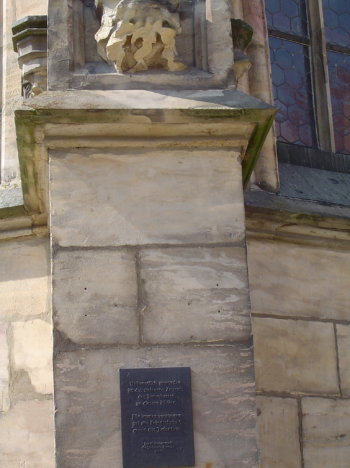Negotiating Sculptures through In_Visibilities
The Case of Anti-Semitic Reliefs in German Churches
1_Setting the Scene Fig. 1: City Church of the Holy Trinity in Bayreuth. The sculpture of the Judensau on the outer wall of the church, removed in November 2004, and the memorial plaque (2005). [1]This conversation takes place in Cologne, the city where we both live. Its landmark is the Cologne Cathedral. Like many other churches throughout Germany, the Cathedral is considered an important landmark and tourist spot, and the Cologne one is certainly among the most famous German monuments. Perhaps you have been to one? If you have, you might have been confronted with an anti-Semitic sculpture depicting people, marked as Jews by caricature, lifting a sow’s tail and suckling on its teats. There were a total of 48 so-called Judensäue in Western Europe and there are still 30 in Germany. [2] They can be found on churches’ facades (the most prominent instances include Roman Catholic as well as Protestant churches), at different heights, as well as in their interior, and some in areas closed to the public. A few of these sculptures have been removed. Next to some of those that remain, commemorative plaques or explanatory signs have been put up. Some remain uncommented upon. Others have decayed, while others yet have been renovated in recent decades. The best-known case is the relief at the Stadtkirche in Wittenberg, a UNESCO world-heritage site and the church where the German priest and theologian Martin Luther (1483–1546) preached, referring to the relief in his anti-Semitic writings. [3] Charlotte remembers first becoming aware of these kinds of invective sculptures on churches during a visit to Magdeburg. In the Magdeburg Cathedral, a leaflet referred to the sculpture, located it historically, and explained that the church congregation critically distanced itself from the sculpture. During her visit at the time, there was no plaque or a similar informative sign, or a critical commentary directly next to the sculpture. Sarah-Lea learned about these sculptures through her work for the German Commission for UNESCO, and found processes of dealing with this difficult heritage to be hesitant at the time. Given that we also both live in Cologne, where such anti-Semitic sculptures can also be found at the landmark of the city, Cologne Cathedral, we wondered what allowed us—or how we allowed ourselves—to remain ignorant of them for so long. Taking diverse routes, from the legal to the activist-artistic, Jewish citizens have demanded an end to this…
